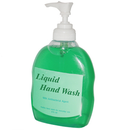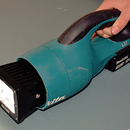Introduction: Starter Motor Repair
This instuctable will show you how to repair a starter motor off a Toyota Corolla FXGT. with a 4AGE engine. don't worry if your car is not the same, most Japanese starter motors are very similar and this guide will get you through most of them.
Step 1: Stuff You Will Need.
First thing to is to check out the price of a new starter motor, There is no point repairing the old one, if it is going to cost you more than a new one. Ebay is a good place to look, also your local auto electrician is worth a phone call.
Tools required
1. socket set
2. set of spanners
3. screwdrivers
4. soldering Iron or torch
5. pliers, side-cutters
6. hammer
7. oil
8. rags
around 3 hours
Step 2: Diagnosis
A faulty starter motor can sound like a flat battery, the engine turns over slowly or not at all, sometimes you can see the battery terminals and leads smoke or get hot due to the high currents been drawn by the faulty starter. First thing, check for other faults. The best way to check the battery is with a load tester but these are expensive, and there are ways around it. Put a volt meter on the battery, it should read, around 12.6 volts. If it is as low as 12.2 volts then charge the battery. Check battery cables are clean and tight and in good condition. If all is good then the best way to check the battery and starter motor is to remove the battery and put it into another vehicle. If the fault moved to the other vehicle, then you have a problem with your battery, Charge it or replace it . If you have eliminated everything else chances are that the starter is faulty.
On page 14 of this instuctable there is a guide to testing the starter motor, this can be done on the car, if you can get to the back of the starter. This can be helpful if the starter is completely dead, not clicking or anything and can help diagnosis a wiring issues with the vehicle or a dead solenoid
Step 3: Starter Removal
First thing to do when doing any repair that involves the high current cables on a motor vehicle is DISCONNECT THE BATTERY, if you skip this step you could end up injuring yourself or setting the car on fire.
Some vehicles it is easier and quicker to remove items that are in the way, rather than try and work around them. I removed the clutch cylinder, battery, O2 sensor cable and cooling fan, this didn't take long and made the job of reaching the starter bolts and physically removing the starter much easier and required much less swearing.
On this car is was the battery cable and solenoid wire was removed from the starter after it was pulled out. On many vehicles you should do this while the starter is still bolted on.
Step 4: Stripping the Starter
Now that you have it out find a clean work area and a container to put all the bits into. Now would be a good time to clean the outside of the starter, I just wiped it over with a petrol soaked rag, so its not all that clean
Make sure you mark the case and solenoid the so it makes it easy to resemble as some parts can be assembled around the wrong way.
1. remove the 2 screws that hold the back cover and brushes in place
2. remove the clip and spring
3. remove the heat shield
4. disconnect the motor cable from the solenoid
5. remove the long blots that hold the motor together
6. remove the brush cover
7. carefully unclip the 2 brushes that are attached to the field windings by pulling back the spring and removing the brush.
8. remove the brush holder
9. remove the field windings
10. unbolt the solenoid and remove the armature and solenoid together.
Step 5: Assess the Damage
Thoroughly do a visual inspection of the field windings, and armature for any burnt or broken insulation, broken wires corrosion or other damage. Also check the commutator on the armature for broken or missing segments If these parts are damaged it may be cheaper to replace the whole starter motor. The pinion gear and solenoid can also be checked for wear or damage.
This starter was quite corroded in places due to the recent flood we have had here, the brushes and bushes are worn, but the rest appears to be in reasonable condition
Step 6: Repairing the Armature and Field Windings
Remove any corrosion with wet and dry sand paper, and the commutator can be sanded and the back of a box cutter knife can be used to clean out between the segments. The insulation between the segments should be under cut to work correctly. Than an oily rag is used to wipe everything to help prevent any future corrosion.
Step 7: Purchase the Parts
After inspecting and cleaning up everything it was decided to only replace the brushes and bushes. The bushes can be removed with socket and a hammer. The bush in the nose of the starter has a cap which can be carefully knocked out with a 1/4" drive extension. A little heat on the alloy nose will help remove the bush. 2 of the bushes are crimped on and can be carefully uncrimped and the brush removed. Take the parts and the identification plate on the field winding and the vehicles chassis number to an auto electrical shop and they should be able to match the pars up total cost should be around $20-$30.
Step 8: Lubricating the New Bushes
The bushes are made from phosphor bronze which is porous and has to be pre-oiled or they will not last very long. This is not to difficult just put it on your finger and fill with engine oil then place your thumb on top and squeeze. Do this 2 or 3 times until you can see the oil coming out the sides of the bush.
Step 9: Fitting the New Bushes
This step can be tricky, and if you have access to a press then use it, as you a much less likely to damage the bushes. First make sure that the housing where the bushes fit into is clean, then fit the bush to the end of the armature and gently tap it in to the housing with hammer. Make sure that the armature is straight and you tap the end of the armature flat with the hammer or it could be damaged. Again a little heat on the alloy end will help fit the bush. Once you have got the bush in about 1/2 way you can use a drift or large punch to drive it into its final position. Again if you use a hammer to do this step, be gentle and get everything straight and flat.
Step 10: Checking the Bushes and Pinon
I like to make sure the bushes are not damaged by fitting the armature without the field windings and checking it all spins without binding. If the pinion needs to be replace simply slide the sleeve down and remove the wire clip. The pinion will slide off. Don't remove it unless you plan to replace it as the wire clip it difficult to remove without damaging it. Some people will tell you not to lubricate the pinion as clutch dust can get into the starter motor and combine with the oil and make the pinion sticky. This maybe true of some older vehicles, I find a small amount of oil help keeps corrosion away and keeps everything working.
Step 11: Fitting the Brushes
Look carefully at the brushes how they are fitted and there orientation. 2 brushes are crimped on, they could be carefully uncrimped with side cutters and new brushes crimped back on. 2 brushes are spot welded on. these 2 were carefully pulled off and a little solder melted on the braid on the end of the brush and on the copper where it was spot welded. The brush is then sweated into position. I use a small gas torch but a large soldering iron would also work.
Step 12: Assembling the Starter
Assembling is straight forward if you know a trick with the brush plate. Don't put the brushes in properly have them half hanging out with the spring jammed against the side of the brush, that it, that's the trick! you can now assemble everything without having to fight with springs. The armature and the solenoid need to go in together and make sure you get the fork in the right spot. If you have been paying attention you will see I've put the solenoid in upside-down, whoops! the bench test will pick that up. The field windings can be fitted and the mark on the side of the motor can be lined up to make it easier to assemble.
Step 13: Assembling the Starter Part 2
The brush plate can now be fitted, and the bushes on the field windings are inserted into the brush holders. Make sure the bolts all line up and then the brushes can be pushed in properly so the springs are pushing down on them. The back plate or brush cover can go on next and the long bolts inserted and done up finger tight. Put one screw into the brush holder to make sure everything is lined up and tighten it all up. Make sure the armature turns freely. The spring and clip can go on next and a little oil on the shaft before screwing the end cap on. The nose of the starter can also have a little oil on the shaft before refitting the cap which is carefully put into position and punched on. The motor cable can be connected to the solenoid and all the bolts and screws re-tightened and re checked
Step 14: Testing
The starter motor can be tested without fitting to the car, and this will find problems like me putting the solenoid in upside-down.
you will need a battery and some jumper leads.
first connect the leads to your battery, and then the negative lead to the case of the starter.
Test 1 checking the motor.
connect the positive lead to the bottom terminal on the solenoid this should make the motor spin, at high speed.
Test 2 checking the solenoid.
connect the positive lead to the small terminal on the solenoid this should make the pinion slide out and engage the ring gear. (this is when I noticed the solenoid up side down as it failed to do this)
Test 3. checking both motor and solenoid.
connect the positive lead to the top terminal on the solenoid. The starter motor should do nothing it shouldn't spark or click. Connect another positive lead to the small terminal on the solenoid the starter should fire up throwing the pinion out and spinning the motor.
If all is well refit the heat shield and it ready to go back on the car and you've saved yourself a couple of hundred $
Step 15: Reduction Box Starter Motor
Reduction box starter motors are becoming more common and have a few differences. They a set of gears inside and use bearing rather than bushes
Just a quick note on solenoids. The type that is fitted to is fitted to our 4AGE starter in the rebuild is not repairable, it doesn't come apart, thankfully they are very reliable. There is another style of solenoid fitted to reduction box starters that is repairable but seem to give more problems, I would definitely be replacing the starter contacts and plunger.













